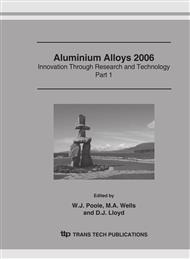p.117
p.125
p.131
p.139
p.147
p.153
p.161
p.169
p.177
Microstructural Characterization and Fatigue Properties of 2195 Al-Li Alloy
Abstract:
The effect of welding, heat-affected zone (HAZ) simulation, and specimen orientation on the microstructure and fatigue properties of 2195 Al-Li alloy was studied. HAZ simulation and GTA welding with a 4043 filler alloy resulted in a significant change in the microstructure. In the HAZ the primary strengthening phase, T1 (Al2CuLi), in the base alloy in T8 temper was replaced by TB (Al7Cu4Li) phase and voids/microcracks, and the fusion zone (FZ) consisted of T (AlLiSi) phase particles in the matrix, which consisted mainly of the filler alloy. The yield strength and fatigue threshold of the 2195-T8 alloy were observed to be dependent upon the specimen orientation. The HAZ simulation and welding led to a reduction in the tensile properties and fatigue strength. While the post-weld heat treatment resulted in the re-precipitation of T1 phase in the HAZ, but no increase in the fatigue strength was observed due to the presence of microcracks. Fatigue crack initiation was observed to occur at the surface in the base alloy in T8 temper, and at the internal defects after HAZ simulation and welding. Fatigue crack propagation exhibited characteristic striations in the T8 alloy, and brittle cleavage-like feature after HAZ simulation and welding.
Info:
Periodical:
Pages:
147-152
Citation:
Online since:
July 2006
Authors:
Price:
Сopyright:
© 2006 Trans Tech Publications Ltd. All Rights Reserved
Share:
Citation:


